The Ultimate Guide to Product Strategy
CHAPTER 1
Why we wrote this product strategy guide
There are many resources to learn about how to work with specialized teams to build and release products. When it comes to strategy however, the discussions center around businesses as a whole, business strategy.
Where does product strategy come in? And why is it important? How does it relate to business strategy and how do leading businesses such as Airbnb, Meta, and Uber define winning product strategies that enable them to succeed?
This is why we wrote this guide, to clarify a topic that is a cornerstone to the product management function.
This detailed guide will clarify what product strategy is by covering the following:
Why is product strategy important? Product strategy helps ensure that business goals are met and products stand out in the market
What are the key elements of product strategy? Goals and initiatives are the two key elements of a strong product strategy
What are the different types of product strategy? Whether focusing on target customers, or differentiating based on quality, there are 5 key ways in which products stand out in the market
How does product strategy relate to product management? Product managers use product strategy to define, build, and support valuable products with their teams
What is a product strategy roadmap? This is a key artifact that visualizes the strategic plans of the product
What are the common questions that are asked related to product strategy? We have outlined them as you work on crafting your product strategy with your team
We will look at these questions structured into 4 parts,
Part 1: Understanding product strategy
Part 2: Elements of product strategy
Part 3: Product strategy in practice
Part 4: Mastering product strategy

Product strategy is what sets great product teams apart from the good ones. It is the cornerstone of the product management function as it enables product teams to build products that generate value for customers and accomplish business goals.
Not that delivery is easy, there are many challenges when it comes to building and releasing great software, however, we don’t exaggerate when we say that strategy is one of the hardest parts of being a product manager.
Strategy is what made Facebook Marketplace the hit product that it is within the Facebook ecosystem, and Spotify the leading player in the audio streaming space.
This is where the toughest brainwork of making essential connections happens after all. Connections between the product and customers, connections between the product and the market, and connections between the product and the business.
Let’s get started!
CHAPTER 2
Understanding product strategy
What is a product strategy?
Merriam-Webster defines strategy as “the art of devising or employing plans or stratagems toward a goal”.
Business strategy is when management defines the steps that a business will take to accomplish particular objectives.
For a business to accomplish its objectives with its product(s) there has to be a plan that connects the product goals to the business goals. Whether these goals are related to revenue, retention, impact, growth, etc, there should be a direct link.
The same goes with being competitive. A business can not be competitive within a market if it cannot differentiate itself from competition. Businesses do this by positioning their product(s) appropriately so that it has a unique value proposition that stands out.
This is the role that product strategy plays.

Product strategy is a plan to develop a product to support business goals, make it stand out in the market, and ultimately, make the company’s vision a reality.
You're looking at a product strategy when you see some sort of goal, a defined path to achieve it, and the resources required along the way (among other factors).
This guide will focus on product strategy. Do keep in mind however that products are offered and sold by businesses.
When a business offers multiple products then the product and business strategy will differ. If, however, a business offers only one product then the product strategy and business strategy will most likely be the same.
Which demands that the business strategy is outlined first, followed by the product strategy.
Why product strategy is important
Product strategy is the logical plan of how a product will drive its part of the company strategy. It’s about how to make the product vision a reality while meeting the needs of the company.
Product strategy is important because it enables product leaders, teams, and businesses to be aware of and focus on the needs of their customers and users, stay abreast of the competitive landscape, and clarify and differentiate their product(s) to reach particular goals.
Without product strategy you will be swimming blind; there is no clear method for how you and your team will define your focus area(s), what to act on, and what to de-prioritize.
Prioritization for product teams is not only about prioritizing what problems to solve and features to build, but also prioritizing where they place their focus.
Once the focus areas are clarified through the product strategy, this then impacts the day-to-day activities of the team.
For example, when determining what makes it onto the roadmap, it should only be those items that align directly with the product strategy.
When performing customer research the goal should be to inform what the product strategy is and assess if the current strategy is serving your customers. Because if it is not, then perhaps it needs to be modified.
When communicating with other stakeholders and team members the communication should center around reminding them what the product strategy is, the progress towards actualizing it, and accomplishments to date.
3 Benefits of product strategy
1. Keeps your team focused and avoids wasted resources
Product teams are constantly challenged with changes: changing company priorities, changing markets, and likewise, constantly changing customer needs and requests.
A business is more likely to become a feature factory when the product strategy is not clear. This means features are added to the product based on requests, sometimes valuing monetary reward over key outcomes, which does not provide much value.
A litmus test can be applied when there is a clear product strategy. When feature requests or ideas are presented, you can easily determine whether they relate to the product strategy.
If they do, then they may be considered. And if not, then it is clear that it is not the right initiative to pursue.
You and your team will have a solid foundation to return to when there are discussions on what to focus on versus what to deprioritize.
Likewise, when stakeholders present competing priorities you can guide them back to the product strategy to determine the best course of action as a team.
2. Clarifies the key use case of your product(s)
In a competitive market with multiple products, a solidified product strategy outlines and clarifies your value proposition.
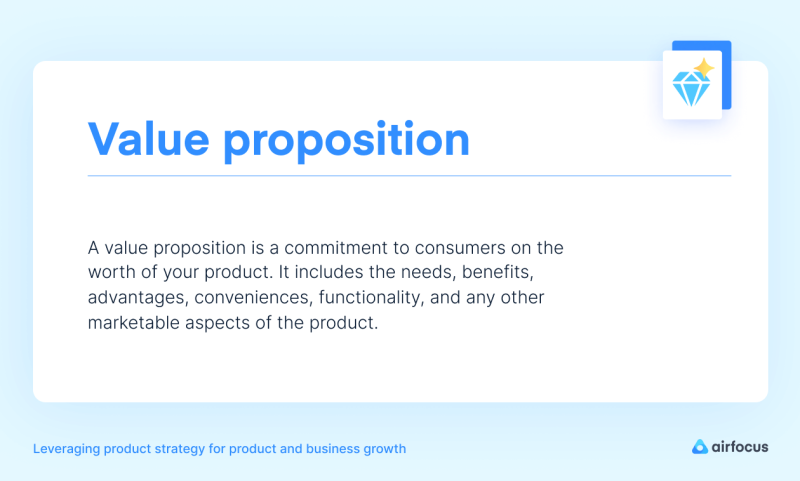
A value proposition is a commitment to consumers on the worth of your product. It includes the needs, benefits, advantages, conveniences, functionality, and any other marketable aspects of the product.
The Value Proposition also demonstrates how the product is superior to its rivals.
Take a look at the ridesharing market, for example, there are a number of competitors in this space.
While Uber is the most popular, there are other notable competitors such as Lyft, HopSkipDrive, Via, Curb, and more.
And this is only in the United States, with even more competitors globally.
While these companies operate in the same industry, they are not the same. And the reason for this is that they have a clear product strategy that differentiates their offering from others.
While some may offer the same core service, their features, and service offerings can differ. The target markets they serve differ, and likewise, their prices differ.
It is your product strategy that will initially set you apart from the competition, and will also determine how you continue to evolve your product to remain competitive.
3. Efficient cross-team alignment
Often when joining new companies, especially product teams, new employees will receive a deck that contains the history of the company, vision, values, markets they serve, their target customer(s), and more.
This information provides a solid foundation for new employees but also gives them a framework for how to make business-related decisions.
For example, when the marketing team is working on a new campaign, they must ensure that they are catering to their target customer.
When the sales team is working on increasing their pipeline, they need to ensure that their demeanor and practices align with the company's values.
The same can be said for the product strategy.
A defined product strategy acts as a communication tool for your company. Similar to a product roadmap, it defines the goals and initiatives to focus on to reach set goals while keeping the vision in mind. With it, everyone in your company will be on the same page and working towards this.
And when there are disagreements on what to focus on, why, or competing resources, everyone can return to the product strategy to determine the best path forward.
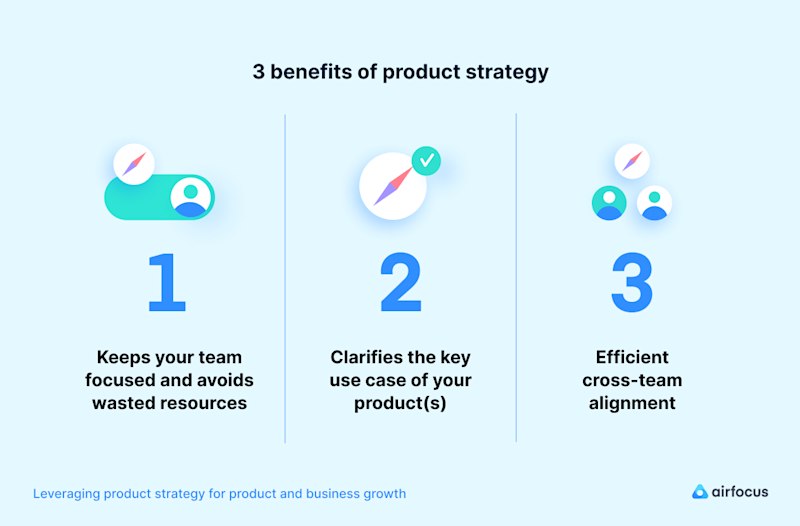
Product strategy vs. product management
One frequent question asked on Google is about the difference between product strategy vs. product management.
It is especially important for aspiring product managers to know this, so they are aware of what they need to learn and their key responsibilities. Business leaders should know this as well to ensure that they hire product leaders who support their business goals.
Product management is the function of defining, prioritizing, and solving customer and business problems with skilled teams.
This includes building digital products that help customers and businesses both reach their goals.
Product strategy is defined and relied on by product managers to accomplish this.
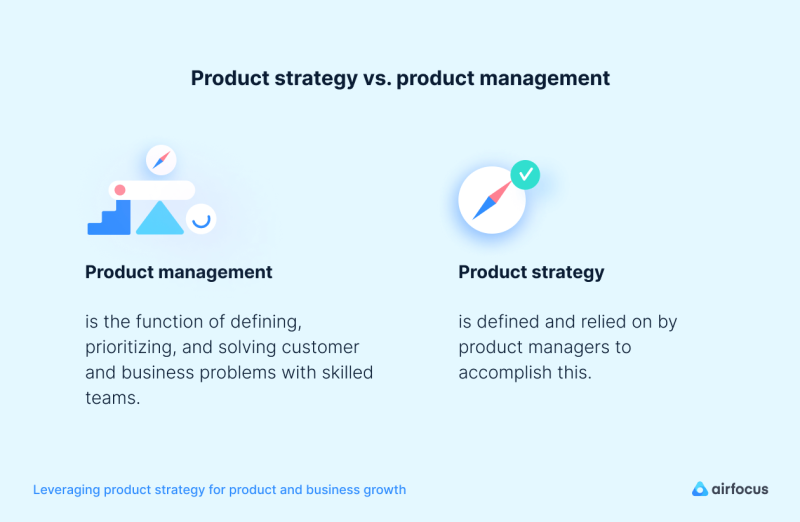
So these two go hand in hand. In fact, product strategy is one of the key aspects of product management.
While a product manager’s responsibilities are many, each one will fall within one of the following 3 categories:
Remaining customer focused
Making data-driven decisions
Supporting stakeholders
The product strategy will clarify which customers you serve and how you will differentiate your product.
Product strategy supports data-driven decisions as the success of initiatives that come from the goals defined in the product strategy will be measured to confirm success and define the next steps.
Product strategy supports stakeholders by clarifying and communicating how the product will develop and the goals and initiatives to support this.
With strategy, execution, and stakeholder management as the key functions of a product manager, product strategy is the cornerstone of product management.
Once the initiatives are defined, the next step is to place these initiatives on your roadmap, the communication tool that outlines to internal and external stakeholders how your product will improve over a set period of time to reach its product vision.
CHAPTER 3
Key elements of a product strategy
As you can see, there are many benefits of having a defined product strategy. But how do you craft an effective one?
There are 2 key elements that makeup product strategy. These are:
Goals
Initiatives
Before these 2, however, there is a central building block needed before diving into the product strategy, that is product vision. Since a strategy has to be built on a vision, we will call this, element 0.
0. Product vision
A product vision describes the future state of a product.
Along with serving as a guide to key stakeholders (internal and external) it also serves as a reminder of the direction that a product will take and what the common objectives for the team are.
The product vision is a central building block of the product strategy. When defined, it helps clarify the strategy and also gives direction to your team.
Everyone knows the direction that the product is heading towards.
A compelling product vision can act as a motivating force. Skilled talent won’t simply join your company for a high salary, but because they are aligned with, and want to support the product vision.
And when employed with the right strategy, defining your roadmap becomes a lot easier, especially prioritization (one of the key responsibilities of product managers).
Here are 3 examples of product vision from some of the world’s leading product companies:
SpaceX: To advance the future.
LinkedIn: To connect the world’s professionals and make them more productive and successful.
Salesforce: We believe that the business of business is to improve the state of the world, and we work to make sure Salesforce is a platform for change through serving the interests of all our stakeholders — employees, customers, partners, communities and the environment.
Product vision vs. company vision
The company vision describes the goals, scope, and future of the company while the product vision focuses more on serving as a guide for stakeholders since it reminds them of the direction the product is taking.
In some cases, where the company has only one product, then the product vision and company vision can be the same. If, however, the company offers multiple products, then the two will differ.
For more on this topic, check out this article on how to align company and product vision.
Product vision vs. product mission
While product vision describes the future state of your product (i.e. the what) the product mission ultimately describes why your product exists.
Here’s an example from LinkedIn:
Vision: To connect the world’s professionals to make them more productive and successful.
Mission: To create economic opportunity for every member of the global workforce.
How to define the product vision?
Define your product vision with a product vision template.
With this template you can answer the questions of why you are creating a product and what it will accomplish in the future.
There are a few templates that are shared by product leaders, such as Roman Pichler, an internationally renowned product management expert, specialized in product strategy, leadership, and agility, which you can find here.
When working on the vision statement, it is important to make it aspirational and concise. The focus here is not on the details of how, but rather the why.
A concise vision statement will define your strategy, inspire your team, and help drive the development of your product.
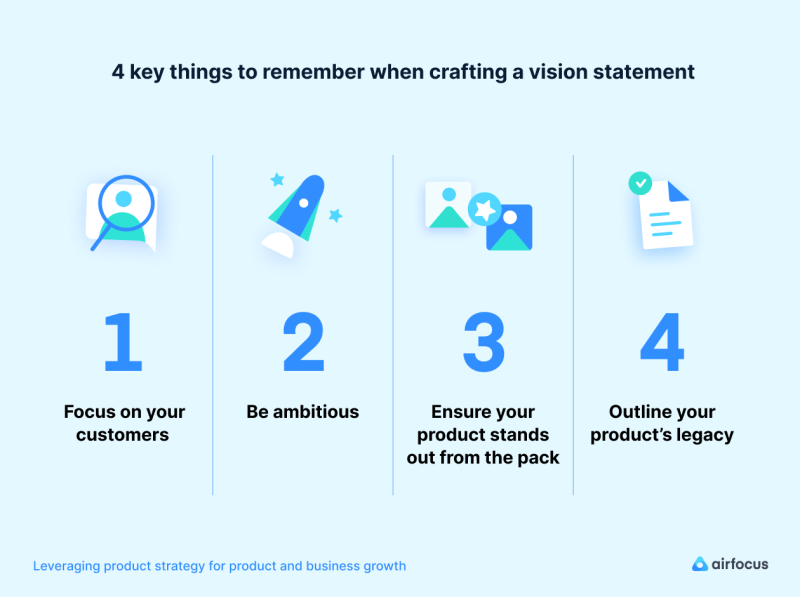
4 key things to remember when crafting a vision statement
1. Focus on your customers
Products are built for the benefit of customers and users, to solve their problems. Your vision statement should clarify this and focus on customer needs.
2. Be ambitious
As the quote goes “Shoot for the moon. Even if you miss, you'll land among the stars”.
Be ambitious with your vision statement.
It should not simply be based on your team’s current capabilities, but rather aim high and inspire your team to go for what they can accomplish with hard work and perseverance.
3. Ensure your product stands out from the pack
Clarify how your product will stand out and set itself apart from competitors in the market.
4. Outline your product’s legacy
What legacy are you building for this product? What lasting impact will it have on the world?
Make this clear in your product vision.
Once you have determined these items, the next step is to use a tool that many product leaders rely on known as the product vision template.
The template will help you follow a structured step-by-step approach that will give you the answers to craft your product vision with specific wording.
These questions can be as stated below:
This is a product for…
Who needs to…
The [product name] is a [product category]
That [benefit delivered by the product]
Which unlike [your primary competitor]
Our product [your Unique selling Proposition (USP) or primary differentiating feature]
Simply fill in the blanks and there you have it, your product vision.
The product vision is the cornerstone of your product strategy. The next step after this is to define the product goals.
1. Product goals
1.While the vision defines how you see your product developing in the future, the product goals define how you can measure if you are achieving the defined vision.
It is imperative that product goals align with the company's goals.
Similar to how the product strategy is based on the company's strategy, the product goals should also align with the company’s goals.
If for example, your company has a goal of increasing revenue by 20% for the year, then you should have a relatable goal for your product. For example, launching a new paid module within your product that is expected to generate additional revenue.
If your company has a goal of achieving a 95% retention rate for the year, then you should have a similar goal surrounding reducing churn, and/or active users for your product.
In the case where there are multiple products, then for a goal such as this the average retention of all products should total 95%. This is how closely the product goals must relate to the company goals.
The second key thing to keep in mind is that your goals need to be measurable.
Without tracking and measuring these goals how will you determine that they are met?
This is where a framework such as Objectives and Key Results (OKRs) comes in handy.
With OKRs you can establish broad, ambitious, measurable goals, along with the specific initiatives that you will focus on to achieve them.
Also, ensure that your goals are time-bound.
The time frame for product goals are normally quarterly and annually. So while you will have goals for the year, there should be goals for each quarter as well.
How to set product goals?
Product goals define how you can measure if you are actualizing the defined vision.
When setting product goals there are 3 key questions that need to be answered for each goal:
What do we want to achieve?
What is the deadline?
How will we measure success?
With regards to the number of total goals for a specific time period, this is based on your team’s capabilities and resources available.
Setting unreachable goals with limited resources is not beneficial, nor is setting too many goals.
How will you know when you are setting unreachable goals, or setting too many?
Product leaders do not work in silos. They do not (and should not) set goals without the input of key stakeholders and their feedback. They also should not ratify their goals before reviewing their budget, available team members, resources, and past data.
Here are some of the areas to assess if you have unreachable goals, or too many:
The budget for the time period is smaller than needed to accomplish the proposed goals
The number of people available to execute on the goals is not enough
There are not enough available resources to accomplish the goal
The time available to accomplish the goals is too limited
The number and scale of goals proposed is similar to those that failed in the past
If any one of the items mentioned holds true, then this is an indication that the proposed goals are unreachable or too many.
Remember, sometimes it is better to set a few ambitious goals that your team can rally around rather than goals that are likely to lead to failure, cause confusion, or scatter resources.
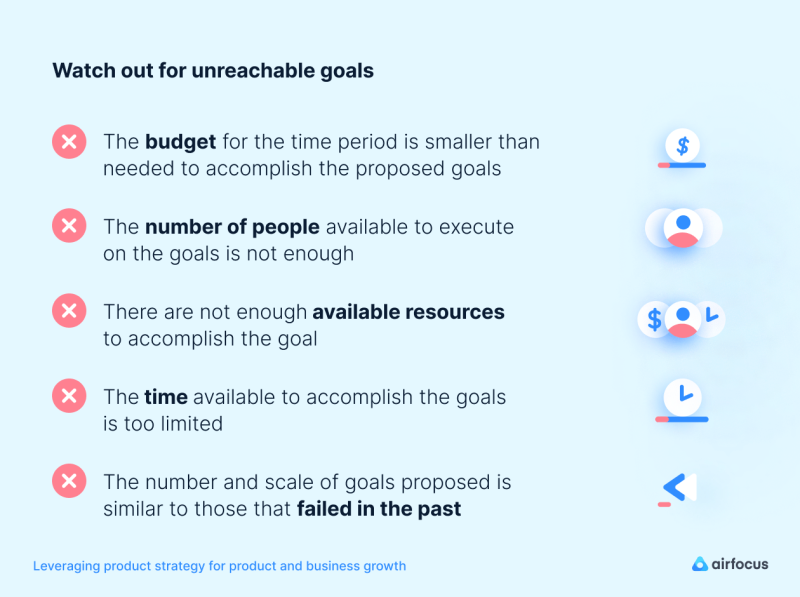
What is one way that businesses set goals?
Setting goals as a business is a collaborative process because everyone in the business owns accomplishing them. Everyone.
The process generally starts with the executives determining the key goals that need to be accomplished for the entire business. This is not done in a silo however, this is done with the knowledge of the market, frequent customer feedback, and inputs from their team throughout the year.
Thereafter, understanding these main business goals, the leaders of each department set their departmental goals, ensuring that these goals directly relate to the goals that need to be accomplished for the business.
This is one of the benefits of using OKRs, it ensures that every department, team, and employee in the business is aligned with the main goals.
OKRs is just one method, however. It's not about the OKRs themselves, but rather how the OKRs are typically defined in a collaborative process. They are defined together.
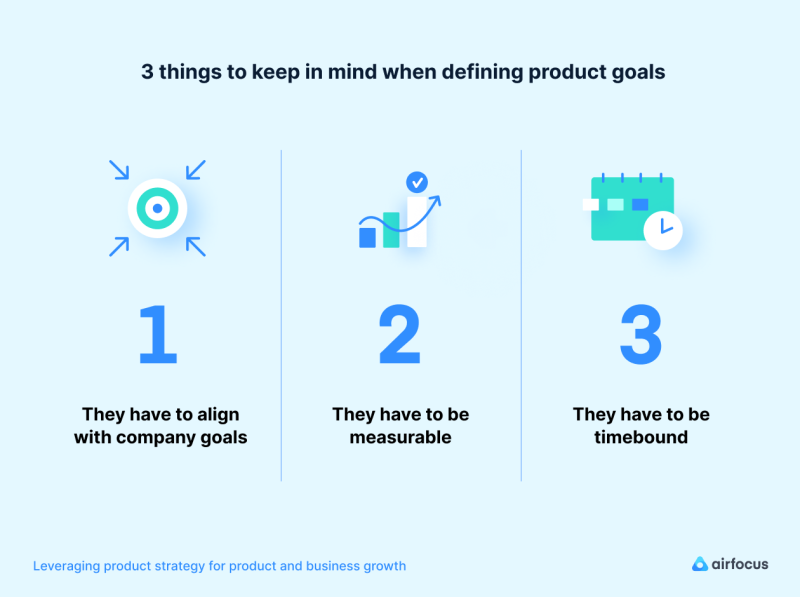
As these goals are being defined, the discussion takes place with cross-functional teams as input from other stakeholders is vital to inform which goals are attainable and which ones are not.
Their input mainly centers around valuable feedback, sharing their research, work, and points of consideration as the goals are crafted.
A simple example of this is the engineering manager providing details on the size and makeup of the engineering team for the following year. This will definitely have an impact on how much work the product team can get done and should be factored into the goals.
You may have noticed that there is no mention of “why” in the 3 questions that need to be answered when setting product goals.
It does not need to be stated explicitly since it is factored into the product vision.
The 3 types of product goals
Product goals are established and worked towards to accomplish larger, more important goals.
Businesses exist to solve problems and make a profit. They continue to succeed by being a viable option in the market(s) they operate within, and this only happens with customer support.
This is where the 3 types of product goals tie in: business goals, market goals, and customer goals. And when setting product goals, it is important for product leaders to ensure that they relate to at least one of these 3.
An example of a business goal is increasing revenue by 30%.
An example of a market goal is becoming the leading solution in the market.
An example of a customer goal is reducing churn by 20%.

Diverse goal setting frameworks
There are multiple goal setting frameworks that product teams utilize. The benefits of these frameworks are that they help provide direction, ensure team alignment, and that goals are measured for success.
SMART goals is a popular goal setting framework however it only applies to single goals.
Another popular one is Objectives and Key Results (OKRs), which ensures the alignment of the entire organization towards shared goals and success metrics.
Another example of organization-wide goal setting is the 4 disciplines of execution method.
Developed by Chris McChesney, Jim Huling, and Sean Covey, this defines a system of execution that enables one to execute even in the most troubling conditions.
These 4 disciplines are:
Focus on the Wildly Important Goals
Act on the Lead Measures
Keep a Compelling Scoreboard
Create a Cadence of Accountability
At airfocus we provide multiple tools and resources to support product leaders and teams to learn and accomplish their goals.
2. Product initiatives
Product initiatives are the high effort items that are expected to provide a lot of impact towards the product goals.
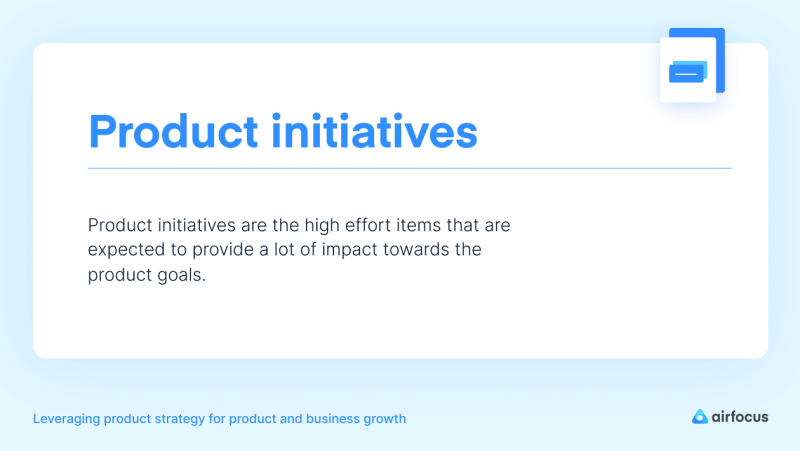
With the high value that they will generate, they require cross-functional work that involves members of other teams. Teamwork is required for product success, not just one department.
While the engineering team may craft a great feature, if marketing is not shouting about it from the rooftops, sales is not sharing the value proposition with prospects, and the product manager is not enhancing the feature based on customer feedback, then the feature will not be successful.
That said however, don't think of product initiatives as simple features, but rather they are large features, or a set of multiple features that are related where the work is medium to high effort.
For example:
Localizing your product so that it is available for an international market
Revamping your user interface to provide a more delightful experience for users
Enhancing the payment experience for customers, to collect payments faster
As you can see, these initiatives will provide a lot of value for customers and the business, involve medium to high effort, and input from other teams.
These initiatives would then be broken down further to opportunities that can be executed upon. This makes initiatives the needed glue, between the everyday work that product teams perform, and the broader strategic moves of the product and company.
Remember, initiatives are drawn from product goals.
The product goals are defined first, and then the initiatives. Not the other way around.
This is one of the key things that differentiates a company that provides value and focuses on outcomes from a feature factory; they begin by stating their goals and then ensure that all of their initiatives and projects tie back to their stated goals.
Check out this article to learn more about product initiatives.
CHAPTER 4
Product strategy in practice
5 types of product strategy
There are 5 different types of product strategy, 5 distinct ways that product leaders set their products apart.
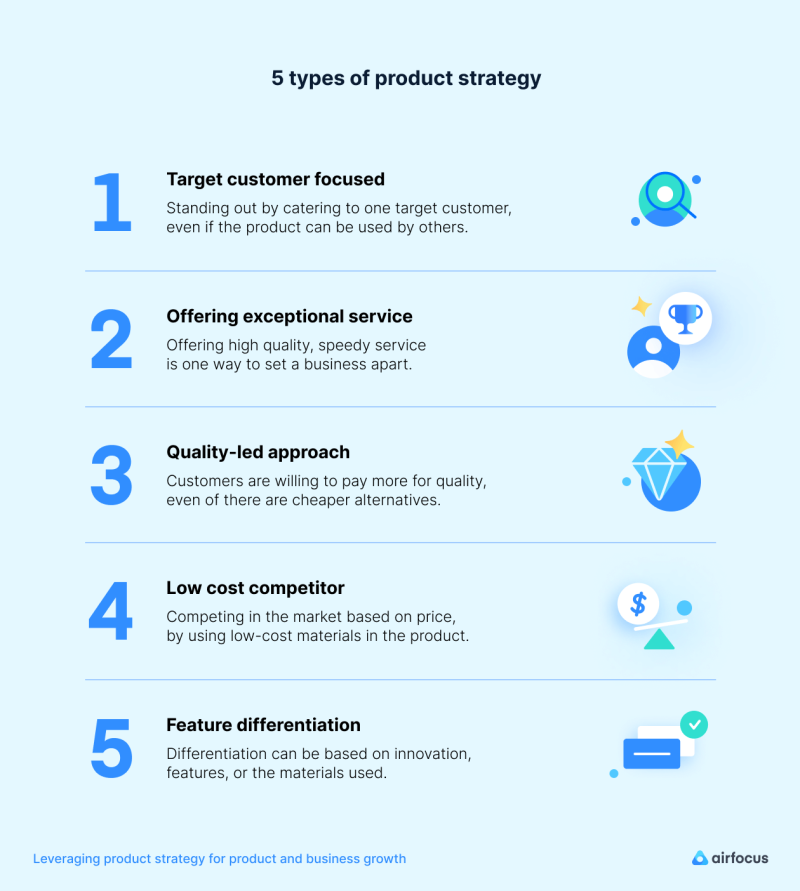
1. Target customer focused
While products can serve many different customers, they should not serve everyone.
When Facebook launched in 2004 it was only available to college and university students. LinkedIn, another social platform, focuses on business professionals.
With this strategy, your product is catered to one target customer.
Others may use and benefit from it; however, how you build, offer, and improve the product is dependent on the needs, wants, and pain points of your target customers.
2. Offering exceptional service
Exceptional service can set your business apart, and this is a key product strategy that many companies use.
They understand that there are customers in the market that are looking for high quality service, and this is what they offer and cater their strategy appropriately.
What does this entail? This means addressing customers' issues at the earliest, responding quickly to customer concerns, offering post-sales services, and more.
A product with exceptional service is one way that products stand apart.
3. Quality-led approach
Android phones are generally cheaper than iPhones, and Windows laptops are generally cheaper than MacBooks.
With lower-priced alternatives available, why do some customers decide to purchase Apple products?
Apple’s product strategy is quality. Not just when it comes to hardware, but the software and design of Apple products, everything is intertwined to offer high-quality to their users and customers.
This is what sets them apart.
This product strategy does lead to higher priced products however this is natural as the inputs to make and support the quality offered are higher.
Customers that appreciate and desire the quality offered are willing to pay the required fee.
4. Low cost competitor
Cost is another common product strategy that is employed. This is where products compete in the market based on price.
While higher quality products are more expensive due to the higher cost of resources required to make them, with this product strategy products are offered at a lower price.
Companies are often able to do this based on the low cost of the resources and materials to make their product(s).
5. Feature differentiation
Many digital products follow this strategy, where they compete based on differentiation.
This differentiation may be based on innovation, features, or the inputs that go into making them, for example, the materials they are made with.
With this strategy, capabilities take the forefront as customers and users choose these products for the value they provide based on their unique value proposition.
These are the 5 distinct ways that product leaders and teams make their product(s) stand out.
While some companies may only employ one of these strategies, other companies do mix them, and there is nothing wrong with this.
There you have it, we have outlined in detail the 2 main components of product strategy (goals and initiatives). Now let’s put this all together with a reliable product strategy framework.
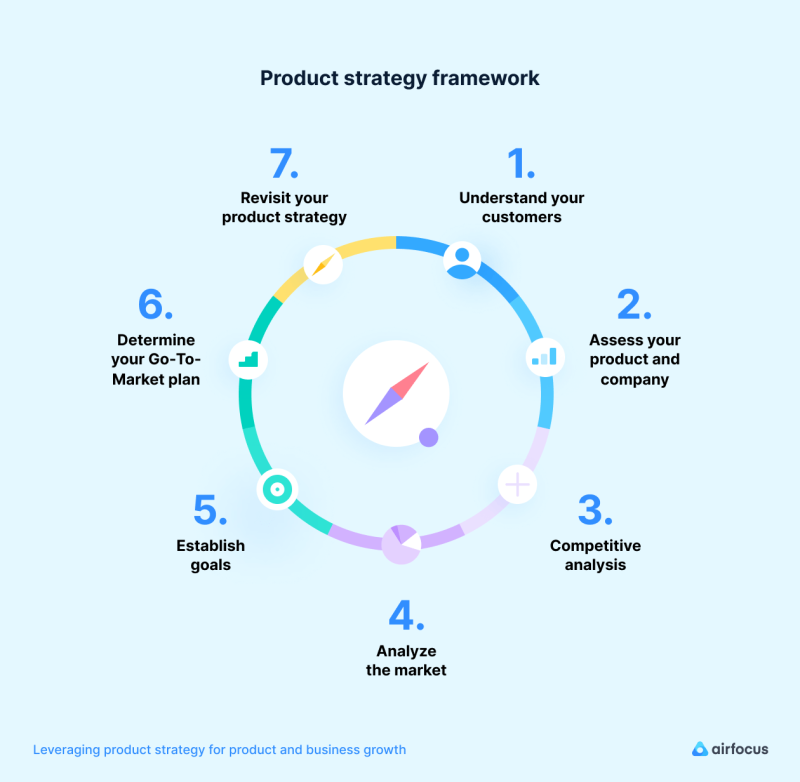
A reliable product strategy framework
A product strategy framework is a conceptual structure that helps you build your product strategy.
Unlike product management frameworks there is not a long list of multiple product strategy frameworks.
Here is a simple one that you can follow, a step-by-step framework as you build your product strategy.
1. Understand your customers
Who are your customers and what are their needs? Of the many customers you have, who is the target customer that you are catering to? And how exactly is your product beneficial to your customers?
2. Assess your product and company
What is it that your product does? What are its core value propositions? What are its strengths, and where does it fall short?
Along with this, what are your company’s strengths and weaknesses?
3. Competitive analysis
Who are the key competitors in the market? Which of them are direct competitors, and which are indirect? What are the strengths and weaknesses of these competitors?
4. Analyze the market
Is the industry that you operate within growing or shrinking? Are investors investing further in the industry or less, and if so, why?
What are industry analysts saying about the industry as a whole? Are key innovations taking place, and if so, what are they, and how can you take advantage of them?
5. Establish goals
What are the key goals that your company hopes to accomplish, and what goals can you establish for your product that assist the company in achieving these goals? What is the timeline for success and how will you measure these goals?
6. Determine your Go-To-Market plan
A Go-To-Market Strategy is a plan of how your company is going to release your product after it has been developed and how it will be sold and promoted within the marketplace.
With this, you should determine your target segments, pricing, and Go-To-Market channels.
Products can not be created to serve everyone, hence the need for segments. This is where you group customers and users into segments based on demographics, interests, needs, and more. So that you can target your messaging and product appropriately to these specific target customers.
The pricing strategy is your method to determine the optimal price to offer your product(s) to customers and users.
Go-To-Market channels refers to the ways in which you will market your product and interact with your customers. These channels include but are not limited to, television, social media, content marketing, SEO, and more.
To determine the best channel(s) to utilize, start with understanding who your customers are and where they encounter the problems you are hoping to solve.
7. Revisit your product strategy
Once your product strategy is defined, similar to constantly reviewing and updating your roadmap, you need to regularly revisit the elements in this framework to analyze your product strategy to ensure that it is effective.
The key thing to determine here is if your product strategy is getting you closer to the product vision or not.
Now that you have a framework in place, let’s discuss how to go from this framework to an actual strategy.
From framework to product strategy
Completing this framework will give you a full picture of your company, your product and an understanding of all sides of the market you operate within.
How does all of the information gathered from the product strategy framework translate into a specific product strategy, however?
The product strategy is the plan to develop the product to support business goals, make it stand out in the market, and ultimately, make the company’s vision a reality.
While vision is not a part of the product strategy, it is a building block.
With the information from your framework in mind, begin by determining which of the 5 product strategies mentioned you will follow.
As a reminder, they are:
Target customer focused
Offering exceptional service
Quality-led approach
Low cost competitor
Feature differentiation
Ensure that the one(s) chosen aligns with your customer needs, product, and company strengths and weaknesses, and factor in the strategy and activities of your competition.
The goal here is to make your product stand out.
Your product vision should already be defined. Ensure that it is clear, succinct, available for your team, and easily understood.
This is the future state of the product that everyone will be working towards achieving.
What comes next are the main components of the product strategy, documenting the goals and initiatives to pursue.
While this information can be recorded on any document, another alternative is to use a product strategy canvas. This is a guide that provides a step-by-step approach to document your product strategy.
Rather than creating one from scratch, check out this product strategy canvas from Melissa Perry, author of Escaping the Build Trap and founder of Produx Labs.
As you can see, this canvas mentions the vision, followed by the goal, which then ends with initiatives to pursue in the format of OKRs.
And there you have it, follow these steps, and you will have a defined product strategy.
With the many tips and advice provided so far, you may have one lingering question: what are the outputs of my product strategy, and how do I work collaboratively with my team to bring it to life?
Great question! And this is exactly where the roadmap comes into play.
The product strategy roadmap
The product strategy roadmapA product roadmap is a tool that outlines the strategic objectives of a business and how the product will evolve to reach set goals.
A product strategy roadmap is a roadmap that visualizes the strategic plans of the product.
It will contain initiatives to pursue, required resources, and more. Communicating grander visions or larger goals for the product.
It clearly identifies what you are working on, and those who view it should be able to identify how addressing these items will support business goals.
This is one of the key roadmaps that product managers rely on.
Coupled with other roadmaps, product managers can work towards their product vision while planning their features, measuring the progress of their objectives, and managing the growth and improvement of their product as a whole.
How does this relate to other more tactical roadmaps? Simply, this roadmap is created first.
Given that it maps out the long-term and high-level goals of the product (tied to business goals), contains general objectives over the more specific ones and is normally reviewed every half-quarter or year, this needs to be established before the roadmaps which define the specific steps to take as well as initiatives that will be worked on in the short-term.
So you can see just how important this roadmap is.
Use airfocus to get started with your product strategy roadmap.
It comes with multiple out-of-the-box product roadmap templates that you can take advantage of. They are also fully adjustable so that you can modify them to your teams’ specific needs.
To learn more about roadmaps, give The Ultimate Guide to Roadmaps a read.
This guide covers everything about roadmaps, from A to Z. You will learn a few tried-and-true strategies from the best product managers to let you successfully build and manage your own roadmaps.
Presenting your product strategy roadmap
A roadmap presentation is an important time for product leaders to share the roadmap with their team.
There are many benefits that come from a roadmap presentation. As we mentioned in The Ultimate Guide to Roadmaps, some of the benefits that come from presenting a product roadmap are that it is an opportunity to:
Align your team on a common mission
Show your team how you will accomplish company goals via the product
Equip your team with the knowledge that they need to perform their work (customer success is now further equipped to speak to customers)
Motivate your team
Evangelize your product.
Here are some key tips to keep in mind when presenting your product strategy roadmap.
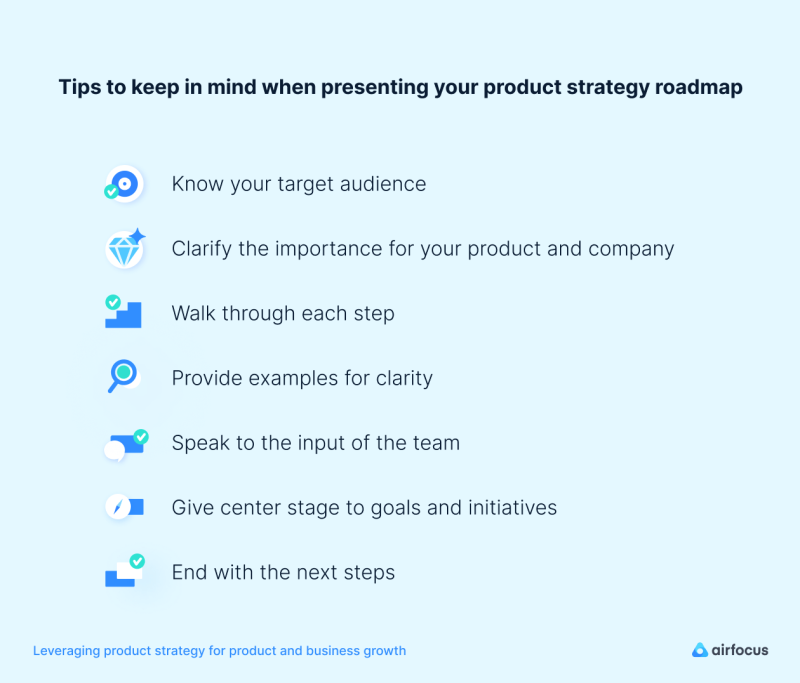
1. Know your target audience
Who are the individuals that you are presenting to? Are they senior executives or new employees?
Based on who they are, their function, and if this is the first time that they are hearing about a product strategy roadmap then this will determine how much content you cover and how deep you go into each portion.
If this is the first time your audience is being presented with a product strategy roadmap then it helps to give them a step-by-step approach of how the product strategy was developed.
2. Clarify the importance for your product and company
Team members may want to see the tangible results of what will be delivered, the tangible features and enhancements that will provide delight to users and customers.
Strategy on the other hand, not everyone may realize or appreciate its importance.
So prior to going into the goals and initiatives, make sure to begin your presentation with a reminder of where product strategy ties in and how a well-crafted product strategy can support the business as a whole with reaching its goals.
3. Walk through each step
Rather than simply informing your team what the product strategy is, walk them through the steps of how it was derived.
This does not need to be a long-winded speech of all of the research performed, various options, trade-offs, etc., just provide an overview of the 3 key components of product strategy and how you defined each one. And mention the other stakeholders that assisted with the process.
4. Provide examples for clarity
For those who are new to product strategy it helps to provide examples of other companies to assist their understanding.
5. Speak to the input of the team
Developing a product strategy is not a solo activity, there is input required from other team members.
When presenting make sure to mention the input that other team members provided.
This will make it clear that this is a holistic approach and that everyone’s involvement is needed to bring this strategy to life.
6. Give center stage to the goals and initiatives
A product strategy consists of the product goals and initiatives while keeping the product vision in mind.
End the presentation by outlining what the goals are and the initiatives to reach them. When speaking on the goals, clarify how they tie to the company goals, and also give the team a chance to share their thoughts.
7. End with the next steps
What’s next after the presentation? Does the team need to meet in a quarter to measure the success of the product strategy? Will another meeting be held to discuss the initiatives? Or will this be followed with a presentation of another roadmap that will clarify the initiatives?
Product strategy roadmap presentations are beneficial to communicate the product strategy, however, don’t leave your team guessing at the end. If there are next steps post this presentation then clarify them and set the follow up meeting.
Along with regular practice and ensuring that you have reviewed the contents of your presentation slides, you should be able to ace this presentation which will be beneficial for supporting your company as a whole with executing on this strategy.
Product strategy roadmap example
You can check out the airfocus public portal here as an example of a strategic roadmap.
Product strategy document
It is likely that you are well aware of a Product Requirements Document (PRD), the document that describes and outlines the importance of a product and acts as a record of all of the features that must be developed to serve customer and business goals.
A lesser known document however is the Product Strategy Document.
This document is extremely important as it comes before the PRD. Before defining the features that need to be built to accomplish customer and business goals and win in the market, the product strategy must be defined first.
If you have not seen or put together a product strategy document, don't worry, we will outline what it looks like and what it contains.
Remember the reliable product strategy framework that we shared earlier in this guide, the 7 steps we provided to craft your product strategy?
Your product strategy document will contain the main items from this framework. It should outline and detail the following:
Customer needs
Product and company assessment
Competitive analysis
Market analysis
Product goals
Go-To-Market
Regular reviews
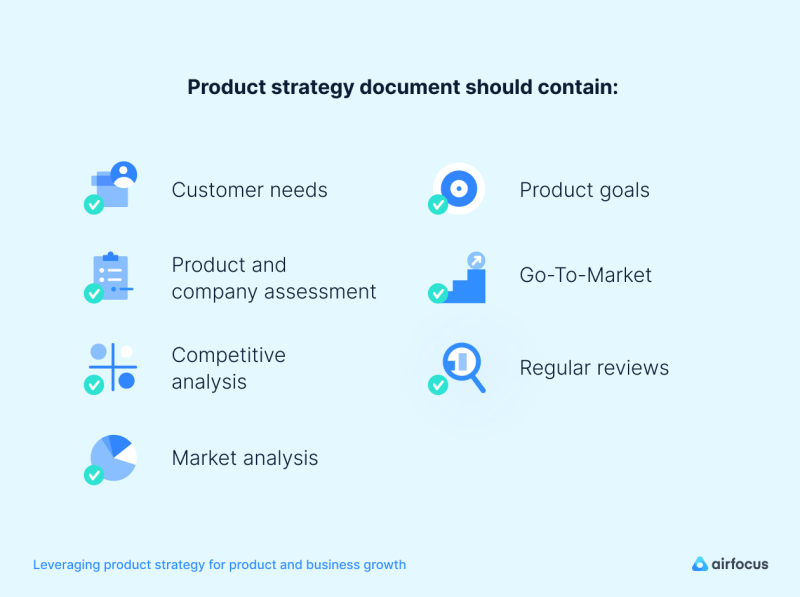
This document does not need to contain all of the research and options that you and your team explored as you worked on the product strategy. It should only contain the final most pertinent information. Remove any fluff.
The benefit of putting this document together is that it serves as the main artifact to outline and clarify your product strategy.
It also acts as the go to source for existing and new team members to understand the defined product strategy.
When a new product manager, product designer, or senior manager joins your company you can simply share this document with them to bring them up to speed.
One last thing to remember here is that there is no standard defined template in the tech industry for this document. So don’t be too concerned about the layout of this document, feel free to add and subtract information as you need and move things around.
The main things to keep in mind are that it must contain the essential items to communicate this information with your team and needs to be easily accessible by all.
CHAPTER 5
Mastering product strategy
Common product strategy questions and their answers
Common product strategy questions and their answersAs you craft the Product Strategy Document, there will be some questions that come about. Likewise, members of your team, especially if this topic is new to them, may have some questions as well. Here is a list of common questions and answers to assist you with defining your product strategy and communicating effectively with your team what product strategy is, how it works, and how it ties into the company strategy.
There are five types of product strategies, can more than one be used at a time?
Definitely, there is no rule that says you cannot.
Some companies for example offer quality products and exceptional service, while others may differentiate themselves based on their feature set and cost.
When building a new product however, it may be best to start by focusing on one.
How important is product strategy for a product manager?
Product strategy plays a pivotal role in product management.
While building products with teams is not an easy feat, strategic skills can set you apart from competition. This is actually one of the key skills that Meta looks for when hiring Product Managers.
Determining what to build, why, and how to set it apart in the market will support your career ladder as a product manager.
Can product strategy come before the business strategy?
Since the product strategy is built on the business strategy then the business strategy must be defined first.
As we mentioned earlier in this guide, if the business only has one product then the business and product strategy may be the same.

How do I improve my product strategy skills?
If a product that you manage does not have a defined strategy then start by implementing the advice in this guide. Understand your business strategy and from this work on defining your product strategy.
It is also beneficial to:
Stay up to date on what’s happening in your industry
Stay abreast of competitor products
Read about the strategy of other companies and products
The last one is key because seeing what other companies and products have done, especially the successful ones, will give you an idea of how to define and/or improve your product strategy.
Also maintain a very close relationship with your customers.
What value does your product strategy have if you’re not solving or serving customer needs?
Being aware of customers needs, wants, and experienced pains will help ensure that you are crafting and modifying your product strategy accordingly.
Jobs-To-Be-Done is a great framework to support this.
Is there a specific framework that’s used to develop product strategy?
Different frameworks work for different companies, teams, and products. And these frameworks can be modified to suit your needs.
For a reliable product strategy framework check out the one mentioned earlier in this guide.
Our content is written and verified by product experts so you can rely on us to provide trusted product knowledge.
Is the product strategy set in stone, and if not, how often should it be modified?
Companies modify their strategy regularly to ensure that they are working towards their vision; the same goes for product strategy.
Product strategy should never be set in stone. It should be defined, shared, and of course measured (via your goals and initiatives), and if market conditions change, competition heats up, or customer demands change, you should modify your product strategy.
When your product strategy is not helping you meet your product vision then modify it.
For example, imagine a company that follows a cost product strategy where they deliver their product at a lower price than their competitors.
If market conditions change and the cost of their resources increase to the point where the business and product is now losing money, then would it not make sense to consider a different strategy? Of course it would!
What do I need to have in place or master before defining my product strategy?
Before you get started on your product strategy there are some key things that you need to know.
These include knowing your company strategy and goals, details on your market, understanding your competitors, their value propositions, and their strengths and weaknesses.
It is also imperative to know the customers you serve. Who are your target customers and their needs, desired gains, and experienced pains?
Without this information you will be creating a product strategy in a vacuum, one that will not reach its vision.
Modern product strategy checklist
Modern product strategy checklistairfocus is a platform that was built for the new way of doing product management. Along with our platform, we continuously support product leaders with strategies, resources, and actionable advice to assist them with modernizing their product processes and accomplishing their goals.
This is why we continue to publish detailed and actionable guides.
Before we let you go we want to provide a quick checklist of actionable steps as you work on crafting and/or improving your product strategy.
Start with the business strategy to ensure that the product goals support your business goals
Leverage the insights and expertise of your team to craft your product strategy and work towards success
Develop your various roadmaps after you have defined your product strategy
Make the key outputs of the product strategy easy to understand and accessible to key stakeholders
Regularly review your product strategy to ensure that it is working
Review this guide for the details on each step, and make sure to check them off as you complete them.
What next?
Now that you have made it to the end of this guide we hope that you have a much better understanding of product strategy, why it is important, how it relates to business strategy, and can define your product strategy with the actionable advice and framework provided in this guide.
We make it a point to share learnings and best practices with our community to take action as they build world-class products.
As you work on defining your product strategy and/or executing on it then consider using a modern product management platform that facilitates product strategy, adapts to your team’s various needs, facilitates communication and delivery across departments while integrating with multiple tools, and more.
Trusted by product teams from all industries, you can book a demo here.

Too busy?
Download now & read later.
Get the PDF
